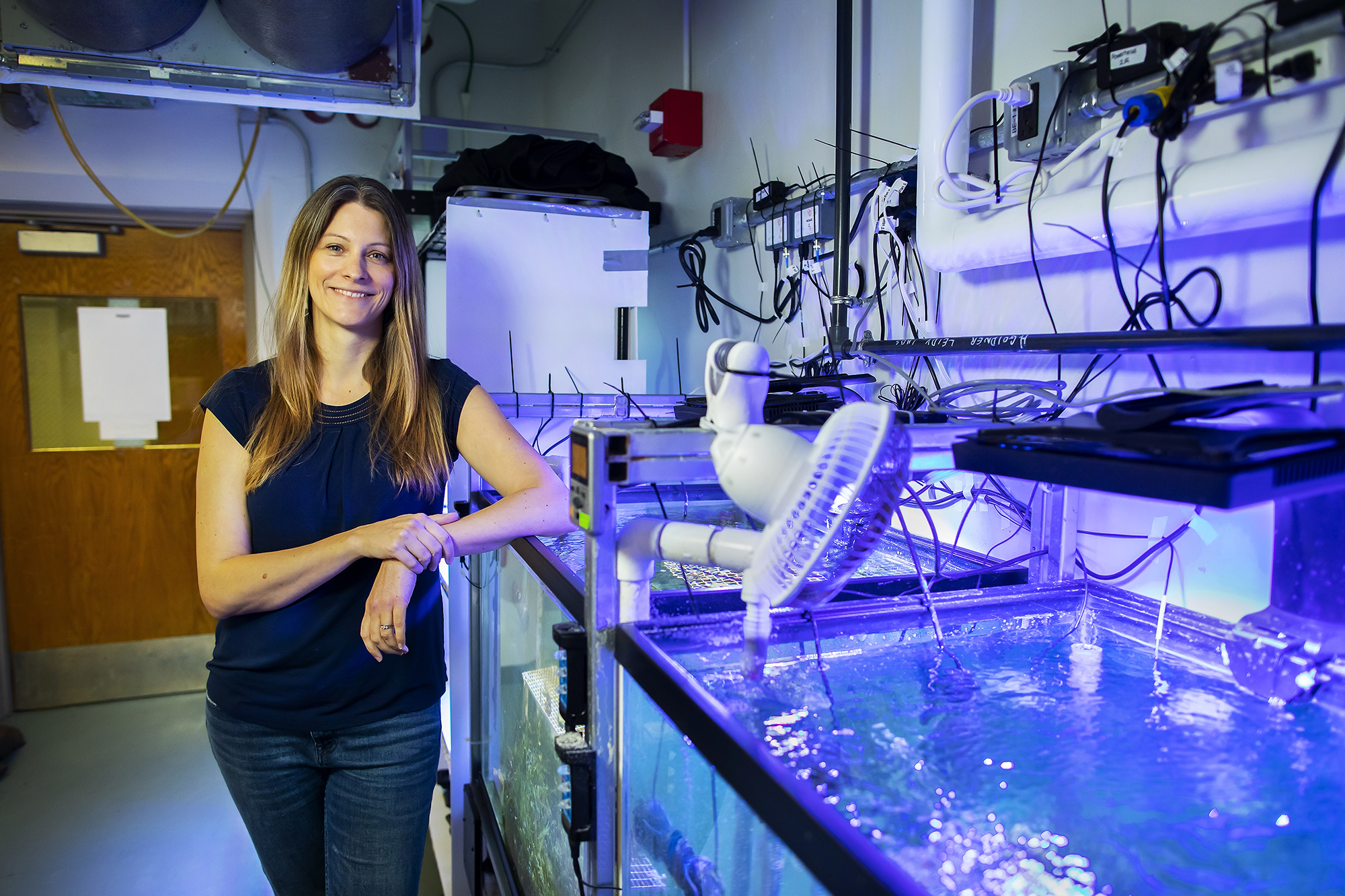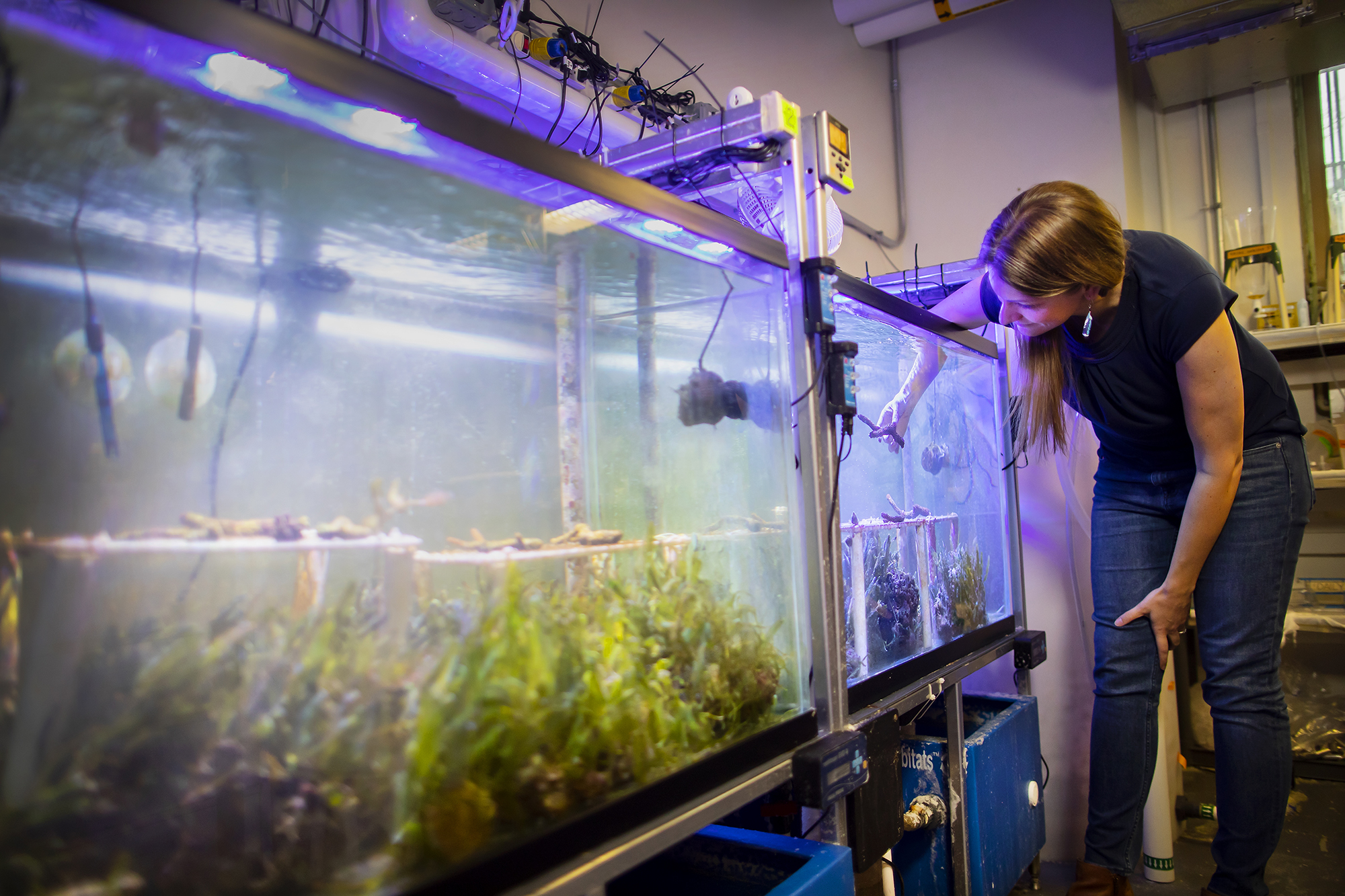
Mass coral-bleaching events, which occur when high ocean temperatures cause coral to expel the algae that dwell inside them, are a relatively recent phenomenon. The first widespread bleaching event occurred in 1983, the year before Penn marine biologist Katie Barott was born.
The next one happened about 15 years later. And the intervals between them continue to shrink. In 2014, one bleaching event in Hawaii was so extreme that it carried over to affect corals into a second summer.
“They’re increasing in frequency, getting closer and closer,” says Barott, an assistant professor in the School of Arts and Sciences’ Department of Biology. “And the ocean temperature is getting warmer and warmer, so the severity is increasing, too.”
Yet as dramatic as the phenomenon sounds—and appears—coral bleaching does not always equate with coral death. Algae can return to corals once ocean temperatures cool, and scientists have observed formerly white corals regain their color in subsequent seasons.
In a multifaceted research project funded by a grant from the National Science Foundation (NSF), Barott and members of her lab are studying the mechanisms by which corals withstand the effects of climate change, which include not only the warmer temperatures that trigger bleaching but also acidification of ocean waters, a slower-moving creep with subtle yet significant consequences.
Barott’s work, based in Kaneohe Bay on Oahu, Hawaii, focuses on two of the bay’s dominant coral species: rice coral (Montipora capitata) and finger coral (Porites compressa). Barott began working there during a postdoctoral fellowship at the Hawaii Institute of Marine Biology, conducting studies on which the new work is based.
Climate threats
Corals are invertebrate animals that live in large colonies, together forming intricate skeletons of varied shapes. To obtain food, they rely heavily on a symbiotic relationship with algae, which establish themselves within the corals’ tissue and produce food and energy for the coral through photosynthesis. A change in temperature or pH can upset this partnership, triggering the algae’s expulsion.
“That leaves the coral essentially starving,” Barott says.
Since her postdoctoral days, Barott has been working with colleagues in Hawaii to monitor coral patches. After the 2014-15 bleaching event, researchers were surprised and heartened to find certain patches of corals didn’t succumb to the bleaching, even those located directly adjacent to stark white corals. And many of those that did bleach bounced back within a month or so of the onset of cooling autumn temperatures.
At the time Barott was writing her NSF grant application, she planned to compare the differences between bleached and unbleached corals. Yet just as the grant kicked off in July, another bleaching event was unfolding in Hawaii.
“That gave us this unexpected opportunity to go back to those same colonies to see if the ones that bleached last time were the same ones that bleached again this past fall,” she says. “And more or less we saw the same patterns: The ones that bleached last time bleached again this time and vice versa. That gives us compelling evidence that there’s something specific about these resilient individuals that is make them resist bleaching, even in very warm temperatures.”
Mechanisms of resilience
While high temperatures triggers bleaching, acidity plays a key role in coral vitality as well. Lower seawater pH impedes corals’ ability to build their calcium carbonite skeletons, resulting in weaker, more fragile structures.
In earlier work, Barott had discovered that corals possess a pH “sensor” that can respond to changes in their environment. And, indeed, sea water acidity can vary widely in the course of a day, a season, or a year, swinging as much as 0.75 pH units in a day. Perhaps, Barott hypothesizes, coral have molecular “tools” that they use to withstand these daily fluctuations that they could also employ to contend with the gradual ocean acidification that is occurring as the concentration of CO2 in sea water rises.
“Maybe there are some reefs that are going to be more resistant to ocean acidification because they’re used to seeing these really large daily swings and are sort of primed to deal with that challenge,” she says.
She’s also curious about how bleaching impacts corals’ ability to tolerate pH changes more generally. Using molecular tools, she and her students are investigating the epigenetic changes that affect how genes are “read” and translated into functional proteins in the organisms. Such changes could occur much more rapidly than coral, a long-lived species, could evolve to deal with a changing environment.
In a variety of projects, the scientists are examining differences between species of coral, between species of the algal symbionts, and between populations located in different places in the Kaneohe lagoon.
Early results suggest differences between the rice and finger coral in their strategies for managing bleaching.
“One really resists the bleaching, but if it does succumb then it fares a lot worse than the one that bleaches more readily,” says Barott. “That one seems to be more susceptible to losing its symbionts, but if it does it recovers fast and has lower overall mortality.”
Planning for the future
Barott’s group is collaborating with others in Hawaii to see if hardier corals could be propagated to rebuild damaged reef communities.
“We’re at the proof-of-principle stage,” she says, “where we’re trying to figure out if some of these differences are heritable.”
While some of that work is being completed in Hawaii, carefully tended tanks in the basement of the Leidy Laboratories of Biology allow Barott and her students to complete experiments in Philadelphia on corals. Using both corals shipped from the field and sea anemones, a useful stand-in for corals due to their ease of care and rapid reproduction, the lab has been tracking the impacts of temperature and pH stress on energy systems, genetics, and even the microbiome of corals, the bacteria with which the corals and algae cohabitate.
“The surface of coral is analogous to the lining of your lungs or intestines,” Barott says. “It’s covered in cilia, it’s got a mucus layer over the top of it, and there are tons and tons of bacteria that live in that mucus layer. We think those bacteria are playing a role in the health of the coral, but we don’t know if it’s playing a role in their temperature sensitivity, so that’s something we’ll be looking at.”
With this “whole organism” approach, Barott’s aims to inject some optimism and scientific rigor into what is a largely dire outlook for corals worldwide. Encouragingly, she notes, this year’s bleaching event in Hawaii was much less severe than predicted, and corals that had bleached in 2014 were less strongly affected by this year’s event.
“These reefs are facing a lot of impacts, not just from climate but also from local development, sedimentation, nutrient pollution,” she says. “Our hope is to predict how corals will respond to these challenges and maybe one day use our findings to assist them in rebuilding resilient reefs.”
Katie Barott is an assistant professor in the University of Pennsylvania School of Arts and Sciences’ Department of Biology.
Much of the work described above is funded by the National Science Foundation (Grant 1923743).








